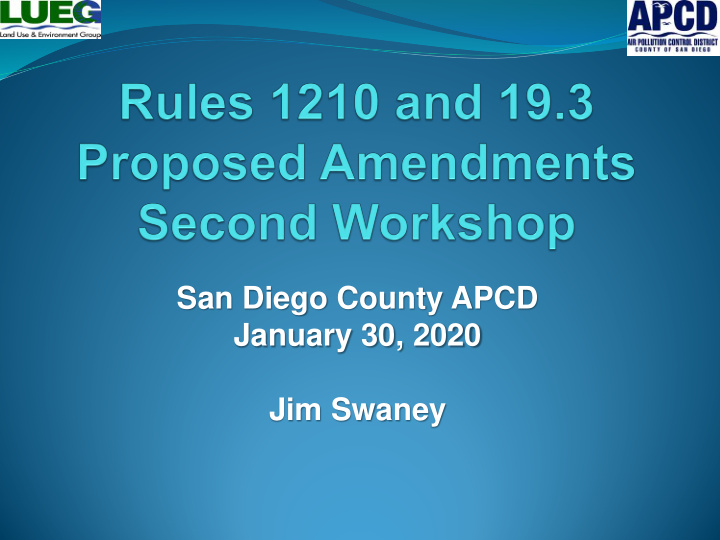



San Diego County APCD January 30, 2020 Jim Swaney
Agenda Background Air Toxics “Hot Spots” Process Health Risk Assessment (HRA) Board Direction Initial Analysis Changes from First Workshop Next Steps 2
Background Air Toxics “Hot Spots” Program (AB2588) Identify facilities with localized impacts Notify residents and businesses of high- risk facilities near them Reduce significant health risks 3
Background Implemented through District Rule 19.3 and state law (emissions inventory) District Rule 1210 (public notification and risk reduction) Guidance and Policy (prioritization and health risk assessment (HRA)) 4
Background In May 2019, District Board directed the District to evaluate lowering the cancer risk reduction threshold District currently has the highest threshold in the State 5
Toxic Air Contaminant Emissions and Cancer Risk * Does not include risk from diesel particulate matter from engines 6
Air Toxics “Hot Spots” Process Emissions Inventory Prioritization Health Risk Assessment (if required) Public Notification (if required) Risk Reduction (if required) 7
Health Risk Assessment Emissions and stack information Dispersion modeling Receptor information Risk Assessment 8
Current Public Notification and Risk Reduction Thresholds Public Notification Risk Reduction Threshold Threshold Cancer Risk 10 in one million 100 in one million Cancer Burden 1.0 1.0 Chronic Noncancer 1.0 1.0 Health Hazard Index Acute Noncancer 1.0 1.0 Health Hazard Index 9
Board Direction May 22, 2019 Board Meeting: Evaluate the current cancer risk 1. reduction threshold Implement regulatory process to 2. analyze reducing the threshold to improve public health Return to Board with proposed rule 3. no later than April 2020 10
Cancer Risk Reduction Thresholds for the 5 Large Air Districts 100 80 60 40 20 0 Sacramento Bay Area South Coast San Joaquin Valley San Diego 11
Initial Analysis Determine which sources potentially would be subject to the different thresholds Used post 2015 “Hot Spots” HRA (if available) Otherwise, used most recent inventory, re-prioritized, ran screening HRA, estimated refined HRA scores 12
First Workshop Recap Workshop August 15, 2019 Discussed options for threshold – only showed one option in draft amended rule language Received 31 comments 13
Options for Cancer Risk Reduction Threshold Threshold # of Potentially Subject Sources 100 in one million Zero 50 in one million 1 25 in one million 2 10 in one million 10 14
Proposed Amendments Rule 1210 Update definitions for consistency with other Rules Remove outdated requirements Potentially lower Cancer Risk Reduction Threshold 15
Changes from First Workshop Rule language showing the 4 options Added voluntary risk reduction option Added technology review option Changed economic cost threshold Removed proposed compliance schedule 16
Risk Reduction Threshold Options Option 1: stay at 100 in one million Not require further reductions from stationary sources Option 2: reduce to 50 in one million Not allow any increases over current risk levels (one source at 53 in one million) 17
Risk Reduction Threshold Options (cont.) Option 3: reduce to 25 in one million Reduce to same level South Coast AQMD uses Option 4: reduce to 10 in one million Reduce to public notification threshold Same level Bay Area and Sac Metro air districts use. 18
Voluntary Risk Reduction Program Similar to South Coast program If above notification, but below risk reduction threshold: 2-½ years to reduce risk District does abbreviated noticing If don’t reduce, do full notification Only for Options 1, 2 and 3 19
Technology Review Option For sources that can’t reduce below Risk Reduction Threshold due to technological limitations Allow additional time if have implemented T-BARCT on certain emission sources Re-evaluate on biennial basis 20
T-BARCT Requirements Toxics – Best Available Retrofit Control Technology Apply to all emission sources: ≥ 1 in one million cancer risk ≥ 0.2 acute or chronic health hazard index 21
Economic Cost Threshold Used to determine if risk reduction measures can be implemented in less than 5 years, or need more than 5 years Currently use 10% of return on equity Propose 10% of profits or 1% of operating budget (non-profit, government, military) 22
Compliance Schedule Specific schedule removed from draft amended rule – no longer needed based on emission inventory status Apply requirements in place when HRA is finalized 23
Proposed Amendments Rule 19.3 Update definitions for consistency with other Rules Remove outdated requirements Add new toxic air contaminant inventory requirements: Annually if high priority under “Hot Spots” (Category A) Biennially if medium priority under “Hot Spots” (Category B) 24
Next Steps Workshop comments due February 14, 2020 Advisory Committee March 2020 Board Hearing April 22, 2020 25
Questions and Comments 26
Contact Information Jim Swaney, P.E. jim.swaney@sdcounty.ca.gov 858-586-2715 27
Recommend
More recommend